List of rock types
The following is a list of rock types recognized by geologists. There is no agreed number of specific types of rocks. Any unique combination of chemical composition, mineralogy, grain size, texture, or other distinguishing characteristics can describe a rock type. Additionally, different classification systems exist for each major type of rock.[1] There are three major types of rock: igneous rock, metamorphic rock, and sedimentary rock.
Igneous rocks
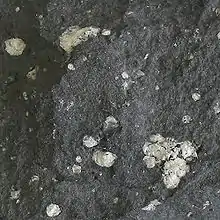
A sample of andesite (dark groundmass) with amygdaloidal vesicles filled with zeolite. Diameter of view is 8 cm.
- Adakite – A class of intermediate to felsic volcanic rocks containing low amounts of yttrium and ytterbium
- Andesite – An intermediate volcanic rock
- Alkali feldspar granite – A granitoid in which at least 90% of the total feldspar is alkali feldspar
- Anorthosite – A mafic intrusive igneous rock composed predominantly of plagioclase
- Aplite – A fine-grained intrusive igneous rock type similar to granite
- Basalt – A magnesium- and iron-rich extrusive igneous rock
- Basaltic trachyandesite
- Mugearite – Oligoclase-bearing basalt, comprising olivine, apatite, and opaque oxides
- Shoshonite – A potassium-rich variety of basaltic trachyandesite
- Basanite – A silica-undersaturated basalt
- Blairmorite – Rare porphyritic volcanic rock
- Boninite – Ultramafic extrusive rock high in both magnesium and silica
- Carbonatite – Igneous rock with more than 50% carbonate minerals
- Charnockite – A type of granite containing orthopyroxene
- Enderbite – An igneous rock of the charnockite series
- Dacite – Volcanic rock intermediate in composition between andesite and rhyolite
- Diabase, also known as dolerite – An intrusive mafic rock forming dykes or sills
- Diorite – Intermediate intrusive igneous rock composed principally of plagioclase feldspar
- Napoleonite, also known as corsite – A variety of diorite with orbicular structure
- Dunite – An ultramafic and ultrabasic rock from Earth's mantle and made of the mineral olivine.
- Essexite – a dark gray or black holocrystalline plutonic rock
- Foidolite – A rare coarse-grained intrusive igneous rock in which more than 60% of light-coloured minerals are feldspathoids
- Gabbro – A coarse-grained mafic intrusive rock
- Granite – common type of intrusive, felsic, igneous rock with granular structure
- Granodiorite – A phaneritic-textured intrusive igneous rock similar to granite
- Granophyre – A subvolcanic rock that contains quartz and alkali feldspar in characteristic angular intergrowths
- Harzburgite – An ultramafic and ultrabasic mantle rock. Found in ophiolites.
- Hornblendite – Plutonic rock consisting mainly of the amphibole hornblende
- Hyaloclastite – A volcaniclastic accumulation or breccia
- Icelandite – An iron rich, aluminium poor andesite
- Ignimbrite – A variety of hardened tuff
- Ijolite – An igneous rock consisting essentially of nepheline and augite
- Kimberlite – Deep igneous rock formed by violent eruption from the mantle which can carry diamonds
- Komatiite – An ultramafic mantle-derived volcanic rock
- Lamproite – Ultrapotassic mantle-derived volcanic or subvolcanic rock
- Lamprophyre – An ultramafic, ultrapotassic intrusive rock dominated by mafic phenocrysts in a feldspar groundmass
- Latite – A silica-undersaturated form of andesite
- Lherzolite – An ultramafic rock, essentially a peridotite
- Monzogranite – A silica-undersaturated granite with <5% normative quartz
- Monzonite – Igneous intrusive rock with low quartz and equal plagioclase and alkali feldspar – a plutonic rock with <5% normative quartz
- Nepheline syenite – A silica-undersaturated plutonic rock of nepheline and alkali feldspar
- Nephelinite – A silica-undersaturated plutonic rock with >90% nepheline
- Norite – A hypersthene-bearing gabbro
- Obsidian – Naturally occurring volcanic glass
- Pegmatite – Igneous rock with very large interlocked crystals
- Peridotite – A coarse-grained ultramafic igneous rock
- Phonolite – A silica-undersaturated volcanic rock; essentially similar to nepheline syenite
- Phonotephrite – A volcanic rock with a composition between phonolite and tephrite
- Picrite – An olivine-bearing basalt
- Porphyry – Textural form of igneous rock with large grained crystals in a fine matrix
- Pumice – Light coloured highly vesicular volcanic rock
- Pyroxenite – Igneous rock - a coarse grained plutonic rock composed of >90% pyroxene
- Quartz diorite – A diorite with >5% modal quartz
- Quartz monzonite – An intermediate plutonic rock, essentially a monzonite with 5–10% modal quartz
- Quartzolite – An intrusive rock composed mostly of quartz
- Rhyodacite – A felsic volcanic rock which is intermediate between a rhyolite and a dacite
- Rhyolite – An igneous, volcanic rock, of felsic (silica-rich) composition
- Comendite – A hard, peralkaline igneous rock, a type of light blue grey rhyolite
- Pantellerite – A peralkaline rhyolite type of volcanic rock
- Scoria – Dark vesicular volcanic rock
- Shonkinite – Intrusive igneous rock – a plutonic rock
- Sovite – A coarse-grained carbonatite rock
- Syenite – Intrusive igneous rock – A plutonic rock dominated by orthoclase feldspar; a type of granitoid
- Tachylyte – Essentially a basaltic glass
- Tephriphonolite – A volcanic rock with a composition between phonotephrite and phonolite
- Tephrite – A silica-undersaturated volcanic rock
- Tonalite – A plagioclase-dominant granitoid
- Trachyandesite – An alkaline intermediate volcanic rock
- Benmoreite – A silica-undersaturated volcanic rock of intermediate composition - sodic trachyandesite
- Trachybasalt – A volcanic rock with a composition between basalt and trachyte
- Trachyte – A silica-undersaturated volcanic rock; essentially a feldspathoid-bearing rhyolite
- Troctolite – A plutonic ultramafic rock containing olivine, pyroxene and plagioclase
- Trondhjemite – A light-colored intrusive igneous rock – A form of tonalite where plagioclase-group feldspar is oligoclase
- Tuff – Rock consolidated from volcanic ash
- Websterite – A type of pyroxenite, composed of clinoproxene and orthopyroxene
- Wehrlite – Ultramafic rock - An ultramafic plutonic or cumulate rock, a type of peridotite, composed of olivine and clinopyroxene
Sedimentary rocks
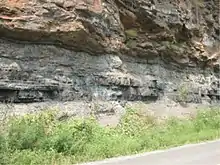
Bituminous coal seam in West Virginia

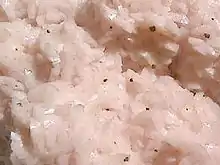
Dolomite crystals from Touissite, Morocco
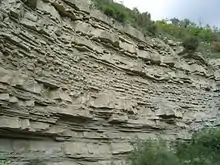
Turbidite (Gorgoglione Flysch), Miocene, South Italy
- Argillite – Sedimentary rock, mostly of indurated clay particles
- Arkose – A type of sandstone containing at least 25% feldspar
- Banded iron formation – Distinctive layered units of iron-rich sedimentary rock that are almost always of Precambrian age
- Breccia – Rock composed of broken fragments cemented by a matrix
- Calcarenite – A type of limestone that is composed predominantly of sand-size grains
- Chalk – A soft, white, porous sedimentary rock made of calcium carbonate
- Chert – A hard, fine-grained sedimentary rock composed of cryptocrystalline silica
- Claystone – Clastic sedimentary rock composed primarily of clay-sized particles
- Coal – Combustible sedimentary rock composed primarily of carbon
- Conglomerate – A coarse-grained clastic sedimentary rock with mainly rounded to subangular clasts
- Coquina – A sedimentary rock that is composed mostly of fragments of shells
- Diamictite – A lithified sedimentary rock of non- to poorly sorted terrigenous sediment in a matrix of mudstone or sandstone
- Diatomite – Soft, siliceous sedimentary rock that is easily crumbled
- Dolomite (rock), also known as Dolostone – Sedimentary carbonate rock that contains a high percentage of the mineral dolomite
- Evaporite – A water-soluble mineral sediment formed by evaporation from an aqueous solution
- Flint – Cryptocrystalline form of the mineral quartz
- Geyserite – A form of opaline silica that is often found around hot springs and geysers
- Greywacke – A hard, dark sandstone with poorly sorted angular grains in a compact, clay-fine matrix
- Gritstone – A hard, coarse-grained, siliceous sandstone
- Itacolumite – A porous, yellow sandstone that is flexible when cut into thin strips
- Jaspillite – A banded mixture of hematite and quartz
- Laterite – A product of rock weathering in wet tropical climate rich in iron and aluminum
- Lignite – soft, brown, combustible, sedimentary rock
- Limestone – Sedimentary rocks made of calcium carbonate
- Marl – Lime-rich mud or mudstone which contains variable amounts of clays and silt
- Mudstone – Fine grained sedimentary rock whose original constituents were clays or muds
- Oil shale – Organic-rich fine-grained sedimentary rock containing kerogen
- Oolite – Sedimentary rock formed from ooids
- Phosphorite – A non-detrital sedimentary rock that contains high amounts of phosphate minerals
- Sandstone – Type of sedimentary rock
- Shale – A fine-grained, clastic sedimentary rock
- Siltstone – Sedimentary rock which has a grain size in the silt range
- Sylvinite – A sedimentary rock made of a mechanical mixture of sylvite and halite
- Tillite – Till which has been indurated or lithified by burial
- Travertine – A form of limestone deposited by mineral springs
- Tufa – Porous limestone rock formed when carbonate minerals precipitate out of ambient temperature water
- Turbidite – The geologic deposit of a turbidity current
- Wackestone – A mud-supported carbonate rock that contains greater than 10% grains
Metamorphic rocks
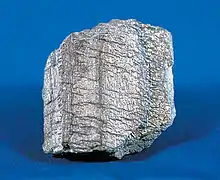
Phyllite

Banded gneiss with a dike of granite orthogneiss

Marble
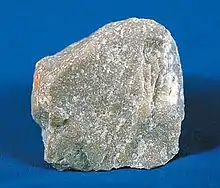
Quartzite
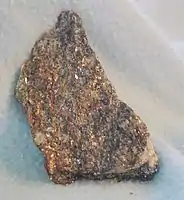
Manhattan Schist, from Southeastern New York
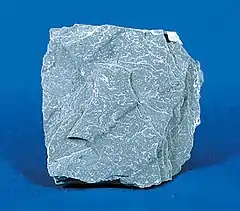
Slate
- Anthracite – A hard, compact variety of coal that has a submetallic luster
- Amphibolite – A metamorphic rock containing mainly amphibole and plagioclase
- Blueschist – A metavolcanic rock that forms by the metamorphism of basalt and rocks with similar composition
- Cataclasite – A rock formed by faulting
- Eclogite – A dense metamorphic rock formed under high pressure
- Gneiss – A common high-grade metamorphic rock
- Granulite – A class of high-grade medium to coarse grained metamorphic rocks
- Greenschist – A mafic metamorphic rock dominated by green amphiboles
- Hornfels
- Calcflinta – A type of hornfels found in the Scottish Highlands
- Litchfieldite – Nepheline syenite gneiss
- Marble – Non-foliated, metamorphic rock, commonly used for sculpture and as a building material – a metamorphosed limestone
- Migmatite – A mixture of metamorphic rock and igneous rock
- Mylonite – A metamorphic rock formed by shearing
- Metapelite – A metamorphic rock with a protolith of clay-rich (siltstone) sedimentary rock
- Metapsammite – A metamorphic rock with a protolith of quartz-rich (sandstone) sedimentary rock
- Phyllite – A low grade metamorphic rock composed mostly of micaceous minerals
- Pseudotachylite – A glass formed by melting within a fault via friction
- Quartzite – Hard, non-foliated metamorphic rock which was originally pure quartz sandstone – A metamorphosed sandstone typically composed of >95% quartz
- Schist – Medium grade metamorphic rock with lamellar grain
- Serpentinite – Rock formed by hydration and metamorphic transformation of olivine
- Skarn – Hard, coarse-grained, hydrothermally altered metamorphic rocks
- Slate – Metamorphic rock - A low grade metamorphic rock formed from shale or silts
- Suevite – A rock formed by partial melting during a meteorite impact
- Talc carbonate – A metamorphosed ultramafic rock with talc as an essential constituent; similar to a serpentinite
- Tectonite – A rock whose fabric reflects the history of its deformation
- Whiteschist – A high pressure metamorphic rock containing talc and kyanite
Specific varieties
The following are terms for rocks that are not petrographically or genetically distinct but are defined according to various other criteria; most are specific classes of other rocks, or altered versions of existing rocks. Some archaic and vernacular terms for rocks are also included.
- Adamellite – A variety of quartz monzonite
- Appinite – A group of varieties of lamprophyre, mostly rich in hornblende
- Aphanite – Igneous rocks which are so fine-grained that their component mineral crystals are not detectable by the unaided eye
- Borolanite – A variety of nepheline syenite from Loch Borralan, Scotland
- Blue Granite – An igneous rock, specifically a variety of monzonite
- Epidosite – A hydrothermally altered epidote- and quartz-bearing rock
- Felsite – A very fine grained felsic volcanic rock that may or may not contain larger crystals
- Flint – Cryptocrystalline form of the mineral quartz
- Ganister – Hard, fine-grained quartzose sandstone, or orthoquartzite
- Gossan – Intensely oxidized, weathered or decomposed rock
- Hyaloclastite – A volcaniclastic accumulation or breccia
- Ijolite – An igneous rock consisting essentially of nepheline and augite
- Jadeitite – A metamorphic rock found in blueschist-grade metamorphic terranes
- Jasperoid – A hematite-silica metasomatite analogous to a skarn
- Kenyte – A variety of porphyritic phonolite or trachyte with rhomb shaped phenocrysts of anorthoclase with variable olivine and augite in a glassy matrix - A variety of phonolite, first found on Mount Kenya
- Lapis lazuli – Contact metamorphic rock containing lazurite, pyrite and calcite - A rock composed of lazurite and other minerals
- Larvikite – An igneous rock, specifically a variety of monzonite
- Litchfieldite – A metamorphosed nepheline syenite occurrence near Litchfield, Maine
- Llanite – A hypabyssal rhyolite with microcline and blue quartz phenocrysts from the Llano Uplift in Texas
- Luxullianite – A rare type of granite
- Mangerite – A plutonic intrusive igneous rock, that is essentially a hypersthene-bearing monzonite
- Minette – A variety of lamprophyre
- Novaculite – A type of chert found in Oklahoma, Arkansas, and Texas
- Pietersite – Breccia rock of hawk's eyes and tiger's eyes
- Pyrolite – A chemical analogue considered to theoretically represent the earth's upper mantle
- Rapakivi granite – A hornblende-biotite granite containing large round crystals of orthoclase each with a rim of oligoclase
- Rhomb porphyry – A type of latite with euhedral rhombic phenocrysts of feldspar
- Rodingite – A mafic rock metasomatized by serpentinization fluids
- Shonkinite – Intrusive igneous rock – melitilic and kalsititic rocks
- Taconite – An iron-bearing sedimentary rock, in which the iron minerals are interlayered with quartz, chert, or carbonate
- Tachylite – A form of basaltic volcanic glass
- Teschenite – A silica undersaturated, analcime bearing gabbro
- Theralite – A nepheline gabbro
- Unakite – An altered granite
- Variolite – Igneous rocks which contain varioles
- Vogesite – A variety of lamprophyre
- Wad – A rock rich in manganese oxide or manganese hydroxide
See also
- List of minerals – A list of minerals for which there are articles on Wikipedia
- List of rocks on Mars – Alphabetical list of named rocks and meteorites found on Mars
- Rock cycle – Transitions through geologic time among the three main rock types: sedimentary, metamorphic, and igneous
- List of rock formations – Links to Wikipedia articles about notable rock outcrops: for a list of unusual or culturally significant rock outcrops
- Leaverite – A specimen in the field that may look interesting but is actually not
References
- "BGS Rock Classification Scheme - Igneous - Metamorphic - Sedimentary - Superficial". British Geological Survey (BGS). Retrieved 2019-05-28.
External links
This article is issued from Wikipedia. The text is licensed under Creative Commons - Attribution - Sharealike. Additional terms may apply for the media files.